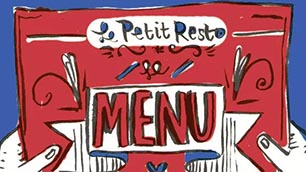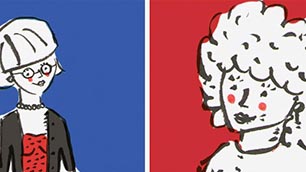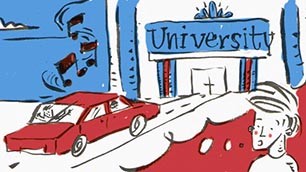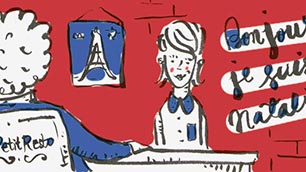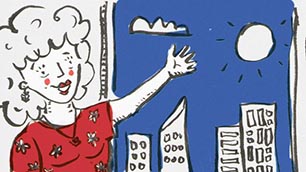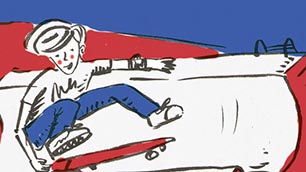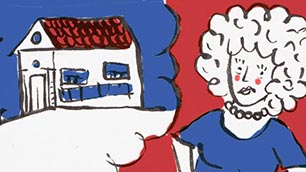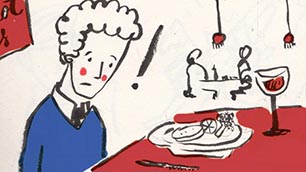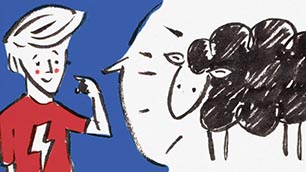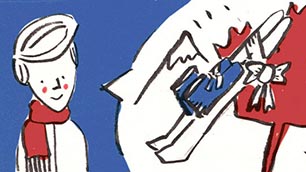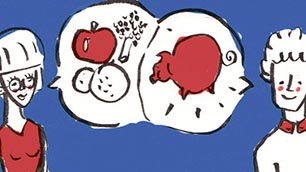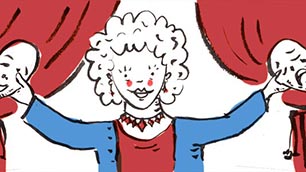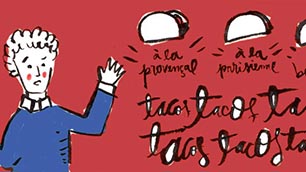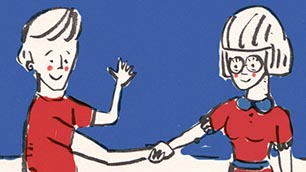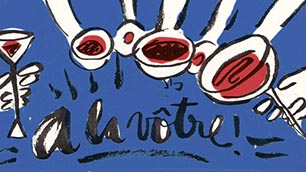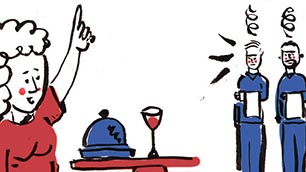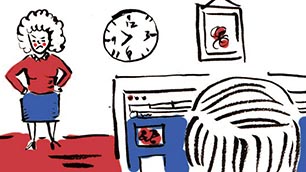| Valérie: | Michelle, for today’s lesson you have learned le verbe aller and the preposition à. |
| Michelle: | That’s a tricky one. |
| Valérie: | It’s true, it takes a little getting used to. What does à mean? |
| Michelle: | It can mean ‘at’ or ‘to.’ |
| Valérie: | What variations of à do you remember? |
| Michelle: | It could be à la if the following noun is feminine. |
| Valérie: | That’s correct. |
| Michelle: | Wait a second! On the street where I grew up, there was this delicious boulangerie called “Pies à la mode”. Is it the same à la ? |
| Valérie: | Oui, it’s the same one. The expression “à la mode” literally means at the fashion or at the way so according to the current fashion or style. |
| Michelle: | Hmm “pies à la mode”... they made fantastic pies with real butter crust. The apple pie was phenomenal. Wait, wait, wait! Do you know what an apple pie à la mode is? |
| Valérie: | Non. |
| Michelle: | It’s apple pie served with a scoop of vanilla ice cream. They made their own honeycomb ice cream which is like burnt caramel in vanilla. It was to die for! |
| Valérie: | So you used to like butter! |
| Michelle: | Oh oui, I was quite chubby at the time. I had to do a lot of cleansing to get where I am now and I’m not about to give it up, even for France’s delicious croissants! |
| Valérie: | Vous avez raison... Anyways, où sommes-nous ? |
| Michelle: | Nous sommes à la. |
| Valérie: | Oui, we use à la for a feminine noun. Par exemple à la boulangerie or à la maison. What about for a masculine noun? |
| Michelle: | It’s au. |
| Valérie: | And plural nouns? |
| Michelle: | Aux avec un x. |
| Valérie: | Parfait. Now, une question difficile. What about if a noun, whether masculine or feminine, starts with a vowel or a silent h? |
| Michelle: | Euh...I can’t remember. |
| Valérie: | You would use à l apostrophe. Par exemple à l'hôtel. |
| Michelle: | I have a mental block with the apostrophe. |
| Valérie: | Maybe you need to eat a little, manger. |
| Michelle: | Manger... non, je n’ai pas besoin de manger. Merci. |
| Valérie: | Now I will give names of places, so nouns with their definite article in front to show the gender and number and you can put the appropriate à in front. |
| Michelle: | These are complicated instructions. Can you give me an example? |
| Valérie: | Sure, if I say le restaurant, you say au restaurant. D’accord ? |
| Michelle: | Ah oui, d’accord. |
| Valérie: | Ok, la plage, the beach. |
| Michelle: | Euh... à la plage. Je vais à la plage. Je vais à la plage en France. J’aime la plage en France, Cannes, Nice... |
| Valérie: | Très bien. You’re making complex sentences already. Another one: le marché, the market. |
| Michelle: | So it’s masculine and singular so... au marché. Tu vas au marché. |
| Valérie: | Excellent. Let’s try l'hôpital. |
| Michelle: | The hospital? |
| Valérie: | Oui. |
| Michelle: | Je n’aime pas l'hôpital. |
| Valérie: | Let’s still make a sentence with à. |
| Michelle: | So I think I just need to put à in front, à l'hôpital. |
| Valérie: | Parfait. |
| Michelle: | Je ne vais pas à l'hôpital. Je déteste l'hôpital. J’ai peur de l'hôpital. |
| Valérie: | Bien, let’s try les Champs-Élysées. |
| Michelle: | Ah les Champs-Élysées, j’adore les Champs-Élysées ! Paris! |
| Valérie: | What will you put in front of les Champs-Élysées? |
| Michelle: | It’s plural so aux avec un x. Je vais aux Champs-Élysées. J’habite aux Champs-Élysées. |
| Valérie: | Très bien Michelle. It’s not so difficult once you get the hang of it. In our second dialog, let’s practice the other uses of aller. |
| Michelle: | D’accord! |
| Valérie: | Bon travail Michelle! |




